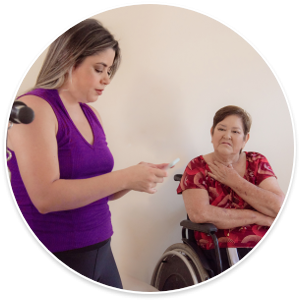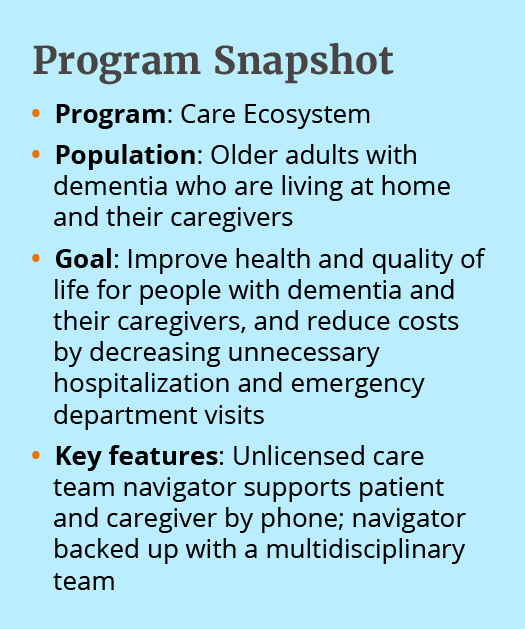By Harris Meyer*
Alzheimer’s and other forms of dementia affect nearly six million people living in the United States, and that number will grow to an estimated 14 million by 2050. Average annual per-person Medicare spending on people with dementia is more than three times higher than for people without dementia.
Health care providers, including neurology and memory care centers, generally diagnose patients as having dementia, then send them back to their regular physicians. At this time, there are limited treatment options for these patients. Yet most hospital systems and physician offices offer no specialized support services for these patients and their families after diagnosis.
Background
Under the leadership of Katherine Possin, PhD, an associate professor of neurology at the University of California, San Francisco (UCSF), the university’s Memory and Aging Center launched the Care Ecosystem program as a research model in 2014, through a Health Care Innovation Award grant from the Center for Medicare & Medicaid Innovation.
“The idea came from the fact that most families living with dementia face the challenges of dementia without much guidance or support from the health system,” Possin said. “We designed a care model to respond to their needs and help them plan for the challenges to come.”
In addition to offering the Care Ecosystem program to UCSF patients in the San Francisco Bay area, UCSF staff consult with seven other provider sites around the country that have launched the model, including the Ochsner Brain Health and Cognitive Disorders Program in New Orleans. Other provider sites around the country have implemented parts of the program. UCSF offers an online toolkit for interested organizations.
Ochsner started the program in 2019 with two private charitable donations of $500,000 each, under the leadership of R. John Sawyer, PhD, a neuropsychologist who is co-director of the Ochsner Brain Health and Cognitive Disorders Program. The program employs two unlicensed care team navigators, a part-time nurse practitioner, and a part-time pharmacist, who collaborate with Ochsner’s multidisciplinary team in the Brain Health and Cognitive Disorders Program.
Ochsner’s Care Ecosystem program has served about 200 individuals with dementia and their caregivers since it started. Most of the patients are over age 65 and in traditional Medicare or a Medicare Advantage plan. About 60 percent are white and 40 percent are African American.
Intervention
The Care Ecosystem model uses unlicensed, trained care team navigators, under the supervision of nurse practitioners, to provide support and education to people with dementia and their caregivers over the telephone and through e-mail. The navigator and the team assist the patients and caregivers with medical needs, behavioral symptoms, legal and financial issues, community resources, and safety concerns.
For example, the Care Ecosystem program at the Ochsner Brain Health and Cognitive Disorders Program in New Orleans has provided intensive education and coaching for the spouse-caregiver of a person with dementia who regularly engaged in sudden outbursts of disruptive physical activity. In a recent situation, the individual threw an object on the ground. Instead of reacting angrily and escalating this behavior, his wife said she took a moment to breathe and calm herself, as she was trained to do.
“She realized it was his brain malfunctioning, not him being rude,” said Sawyer, whose program drills caregivers in the three R’s of dealing with people with dementia – repeat, reassure, redirect. “She reset her mind and didn’t freak out. That’s a huge win when you see how reactive spouses can get when the person is declining.”
“The caregivers know they can always call a navigator and talk something through,” he added. “That’s extremely helpful to the caregivers when they are anxious. And it reduces unnecessary emergency department visits that may turn into hospitalization.”
Implementation
Providers in the Ochsner Brain Health and Cognitive Disorders Program refer patients who have been diagnosed with some degree of dementia to one of two Care Ecosystem care team navigators, who have received 40 hours of training. They typically are recent college graduates interested in health care or social work careers.
To be eligible, patients must live in the community, not in a long-term care facility, have visited the emergency department (ED) within the past 12 months, and have an identified caregiver. The program prioritizes patients at higher medical risk who place a substantial burden on their caregivers.
The navigator initially meets with the team of dementia care specialists, including a nurse practitioner, pharmacist, and social worker, to develop a care plan for the patient and caregiver, called the dyad.
The care plan covers medical and medication needs, behavioral and safety issues, legal and financial issues, as well as the physical and emotional health of the caregiver. The navigator continues to meet weekly with the team to discuss the case. In addition, the navigator and care team members keep the regular medical provider of the patient with dementia up to date.
As at other Care Ecosystem sites, Ochsner’s care navigator primarily works with the family caregiver, contacting the person by phone or videoconference at least once a month, sometimes more if necessary. When issues arise beyond the navigator’s training, the navigator brings in the licensed members of the care team to provide support.
Through careful listening, the navigators help caregivers by providing disease education and resources. They offer advice on issues including managing behaviors, depression, hallucinations, eating, gun safety, financial planning, and long-term care, said Sarah Dulaney, the nurse coordinator for UCSF’s Care Ecosystem study. The team also helps families come up with strategies for sharing the caregiving burden. In addition, they discuss the possible need for hospice care.
“A lot of caregivers are between a rock and a hard place on what to do,” she said. “Our participants appreciate having someone who can help them think through things.”
The patient and caregiver “graduate” from the Ochsner program at the end of 12 months, Sawyer said. “That doesn’t mean we’ll never talk to you again,” he explained. “But it’s gotten to the point where the caregiver can manage the situation and come back to us as needed.”
Currently, the Care Ecosystem programs around the country are funded by research grants and charitable contributions and are not reimbursed as covered benefits by public or private insurers. Possin and her colleagues are working with the Alzheimer’s Association and the Alzheimer’s Impact Movement to develop an alternative payment model that could be tested by the Center for Medicare & Medicaid Innovation.
There is also potential for Care Ecosystem providers to use Medicare’s Comprehensive Care Management billing codes to receive reimbursement, though those payments may not be adequate to support the services, according to a 2019 study.
Impact
The randomized controlled trial of the Care Ecosystem program showed improved quality of life for people with dementia, reduced ED visits, and decreased caregiver depression and burden for rural and urban participants in three states. Average cost savings per patient over a one-year period for ED visits, ambulance use, and hospitalizations was $600.
“You don’t expect the total cost of care to go down for a condition that gets worse every year,” Sawyer said. “But it’s neat to see we reduced both ED visit frequency and also the expense of an ED visit, because the patients are appropriately diagnosed and the ED doctors don’t order unnecessary tests.”
The average annual cost of providing the Care Ecosystem program was $2,892 at UCSF and $1,704 at University of Nebraska Medical Center. Lower per-person cost was associated with a higher caseload per care team navigator.
Another study on the model found that 92 percent of caregivers reported that they could nearly always trust their care team navigator in the Care Ecosystem program and that the navigators were nearly always responsive (90%) and knowledgeable (79%).
While there are somewhat similar collaborative care programs for people with dementia at other health systems around the country, such as University of California, Los Angeles, Johns Hopkins, and Indiana University, what makes the Care Ecosystem program unique is that it is telephone-based and features a major role for unlicensed navigators, Possin said.
“It’s less expensive than some programs, but it also meets caregivers where they are,” she said. “They can just pick up the phone if they need help. Most of the issues can be addressed over the phone.”
Insights
Following are key program lessons:
The patients’ regular physicians are delighted to see their patients receive this support.
It’s not difficult to get buy-in from primary care physicians and neurologists, Possin said. “They feel it will save them time and address a lot of issues between visits.”
The program is best suited to value-based payment arrangements.
As noted earlier, Possin is working with the Alzheimer’s Association, to develop a capitated and performance-based payment structure for reimbursing providers through a Medicare demonstration program.
Meanwhile, Sawyer is working on generating data to show health system leaders that there is a return on investment for funding the Care Ecosystem program themselves. It helps to have a strong data infrastructure to capture cost and outcomes data before, during, and after the intervention, he said. “When hospital margins are tighter and tighter, it’s harder to break through with administrators without demonstrating a value case,” he added.
You can pitch the Care Ecosystem program to stakeholders by stressing the problems it would help with.
“What are the pain points a program like this could address?” Dulaney said. “Are a lot of people with dementia ending up in the ED and the ED doesn’t know what to do with them? Is there a long wait list for patients seeking a diagnosis? That’s what gets people’s attention.”
Acknowledgements
Thanks to Katherine Possin, R. John Sawyer, and Sarah Dulaney for helping to inform this blog post.
* Author Harris Meyer is a freelance journalist who has been writing about health care policy and delivery since 1986.



